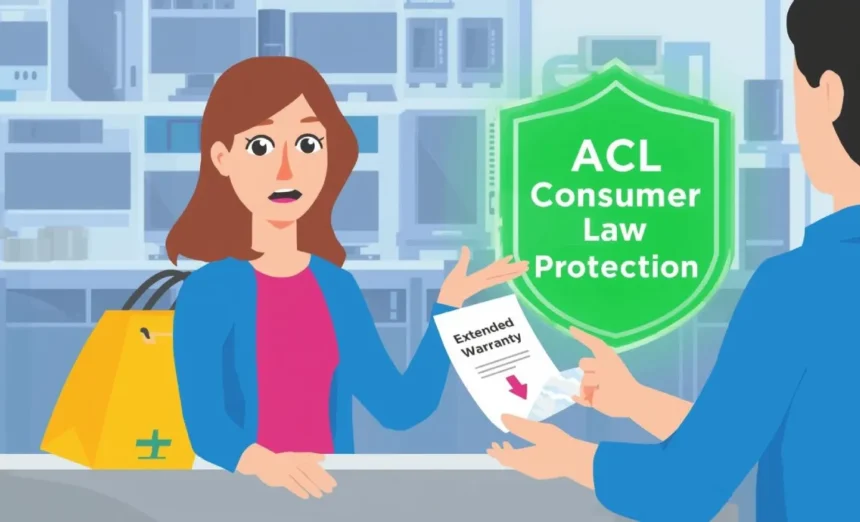Walking into a retail store to buy a new TV or laptop often ends with the same sales pitch: “Would you like extended warranty protection?” Many Australians fork out hundreds of extra dollars believing they need this coverage to protect their purchase. But here’s the catch—you’re likely already protected under Australian Consumer Law (ACL), and that extended warranty might be doubling up on rights you already have.
Extended warranties in Australia have become a significant revenue stream for retailers, yet consumer advocates consistently warn they’re often poor value. Understanding your automatic protections under the ACL can save you from unnecessary spending while ensuring your purchases remain properly safeguarded. This guide reveals why extended warranties frequently waste your money and empowers you with the knowledge to make informed decisions at checkout.
What Are Extended Warranties and How Do They Work?
Extended warranties, also called extended protection plans or service contracts, are optional insurance-like products retailers offer at the point of sale. Unlike the manufacturer’s warranty that comes standard with your purchase, extended warranties are sold separately—and they come at a cost that can range from $50 for small electronics to over $500 for major appliances.
These warranties typically promise coverage beyond the manufacturer’s warranty period, often extending protection for one to five additional years. Retailers present them as safety nets against product failures, repairs, and sometimes accidental damage. However, the reality is far more complex than the sales pitch suggests.
Common types of extended warranties offered in Australia include:
- Standard extended warranties – Cover mechanical or electrical failures after the manufacturer’s warranty expires
- Accidental damage protection – Promises coverage for drops, spills, or screen damage (often with significant exclusions)
- Store-brand protection plans – Retailer-specific schemes with varying terms and conditions
- Manufacturer extended warranties – Direct from the brand, sometimes offering slightly better terms than third-party options
Example: A $1,200 laptop purchased at a major Australian retailer might come with a one-year manufacturer’s warranty. The salesperson then offers a three-year extended warranty for $299. That’s nearly 25% of your purchase price for coverage that may duplicate protections you already possess under Australian Consumer Law.
The critical issue many Australians miss is that these warranties are entirely separate from your statutory rights. Purchasing one doesn’t enhance your ACL protections—it simply creates another layer that may prove redundant or difficult to claim against when something goes wrong.
Understanding Your Rights Under the Australian Consumer Law
The Australian Consumer Law provides automatic guarantees that protect every consumer purchase in Australia. These aren’t optional extras you pay for—they’re your legal rights the moment you buy anything, whether it costs $50 or $5,000. Many Australians remain unaware of how comprehensive these protections actually are.
Under the ACL, products must be of acceptable quality, fit for purpose, match their description, and be safe. When goods fail to meet these guarantees, you’re entitled to a remedy—whether that’s a repair, replacement, or refund. Importantly, these rights extend well beyond any manufacturer’s warranty period, covering products for a “reasonable” timeframe based on the item’s nature and price.
Your ACL guarantees include:
- Right to acceptable quality – Products must be safe, durable, and free from defects
- Fit for disclosed purpose – Items must work for the specific purpose you discussed with the seller
- Match description and sample – Products must match what was advertised or demonstrated
- Right to remedy – You can claim repair, replacement, or refund when guarantees aren’t met
- Coverage beyond warranty periods – ACL protection lasts as long as is reasonable for that product type
| ACL Guarantees | Typical Extended Warranty |
|---|---|
| Automatic and free | Costs extra ($50–$500+) |
| Covers manufacturing defects indefinitely within “reasonable” timeframe | Limited term (1–5 years typically) |
| Enforceable by law | Contract-based, often with loopholes |
| No excess fees | May include claim fees or excesses |
| Applies to all retailers | Only valid with specific retailer/insurer |
Case study: A Sydney consumer purchased a $2,800 washing machine that failed after 18 months—three months after the manufacturer’s warranty expired. The retailer initially refused to help, directing the customer to pay for repairs. After citing ACL protections, the retailer provided a free replacement. A washing machine at that price point should reasonably last several years, making the failure a breach of acceptable quality guarantees—no extended warranty needed.
The ACCC (Australian Competition and Consumer Commission) regularly reminds retailers that they cannot contract out of consumer guarantees. This means even terms and conditions can’t override your ACL rights. Extended warranties should be additional to—not instead of—these protections.
ACL Coverage vs Paid Warranties: Why You Often Don’t Need Extra Protection
The overlap between ACL protections and extended warranties represents the core reason these add-ons often waste money. In most scenarios where a paid warranty would apply, your ACL rights already provide equivalent or superior coverage—completely free.
Extended warranties typically cover manufacturing defects and component failures. But the ACL already guarantees products must be of acceptable quality and fit for purpose for a reasonable period. For a $1,500 television, “reasonable” likely means several years, not just the 12-month manufacturer’s warranty. When that TV fails after two years due to a faulty component, you have ACL protection whether you bought an extended warranty or not.
Price comparison example:
- Extended warranty cost: $300 for three years of coverage
- ACL claim cost: $0 (your statutory right)
- Potential savings: $300 by understanding your existing protections
The extended warranty industry relies on consumers not understanding their ACL rights. Sales staff often create urgency—”You must purchase this today or you’ll have no protection after the manufacturer’s warranty expires.” This statement is misleading at best. Your ACL guarantees don’t expire when the manufacturer’s warranty does.
Scenarios where warranties overlap with ACL:
- Manufacturing defects appearing within the reasonable lifespan of the product
- Component failures in appliances, electronics, or furniture
- Products not lasting as long as consumers could reasonably expect
- Items not matching their advertised quality or specifications
Where extended warranties sometimes claim to add value is in covering accidental damage—drops, spills, screen cracks. However, these policies come loaded with exclusions, excess fees, and claim limits that significantly reduce their practical value. Many consumers discover their “comprehensive” accidental damage cover excludes the exact incident they’re claiming for.
A 2023 consumer study found that less than 20% of extended warranty purchasers ever make a claim, whilst retailers typically have profit margins of 50–80% on these products. That’s a strong indicator you’re paying for protection you won’t use or that’s already provided elsewhere.
Common Pitfalls of Extended Warranties in Australia
Beyond the redundancy issue, extended warranties are riddled with traps that further diminish their value. Understanding these pitfalls helps explain why consumer advocates consistently warn against purchasing them.
1. Hidden exclusions and fine print Extended warranty contracts often contain extensive exclusions buried in lengthy terms and conditions. Cosmetic damage, normal wear and tear, unauthorised repairs, or even failing to maintain the product according to specific guidelines can void your coverage. Many consumers only discover these exclusions when their claim is rejected.
2. Difficulty making claims The claims process for extended warranties can be deliberately complex. Unlike ACL claims made directly to the retailer, extended warranties often require contacting third-party insurers, completing extensive paperwork, and waiting weeks for approval. Some consumers face multiple rejections before claims are honoured.
3. Time-limited coverage that doesn’t match product lifespan A three-year extended warranty might sound comprehensive, but if your $3,000 refrigerator should reasonably last 10 years, that warranty leaves you unprotected for most of the appliance’s life. Your ACL rights continue throughout the reasonable lifespan regardless.
4. Non-transferable policies Move house, gift the item, or sell it second-hand? Many extended warranties don’t transfer to new owners, making them worthless if your circumstances change. ACL guarantees, however, can be pursued by subsequent owners in many situations.
5. Retailer or insurer insolvency If the company that sold you the extended warranty goes bust, your coverage disappears. This happened to thousands of Australians when Dick Smith Electronics collapsed in 2016. ACL protections remain enforceable against suppliers and manufacturers even if the original retailer fails.
Example: A Melbourne consumer paid $180 for accidental damage coverage on her smartphone. When she cracked the screen eight months later, the claim was denied because she couldn’t prove the exact date and circumstances of the damage—a requirement hidden in the policy terms. She ended up paying for repairs out of pocket whilst the warranty company kept her $180.
The ACCC regularly takes action against retailers for misleading conduct around extended warranties, including failing to properly disclose ACL rights or misrepresenting that warranties are necessary for consumer protection.
When, If Ever, Extended Warranties Might Make Sense
Despite the general advice to avoid extended warranties, rare circumstances exist where they might provide value. The key is approaching any decision analytically rather than emotionally at the point of sale.
Extended warranties might be worth considering when:
- Extraordinarily high-value items – For purchases exceeding $10,000 where even with ACL protection, you want absolute certainty of coverage and potentially faster service
- Items with higher-than-average failure rates – Certain product categories have documented reliability issues where extended coverage might provide peace of mind
- Specialist equipment with limited repair options – Professional or niche equipment where ACL claims might be complex and extended warranties offer clearer coverage
- Genuine gap coverage – Policies that specifically cover accidental damage with clear terms and reasonable excess fees (though these are rare and expensive)
Decision framework for Australians:
- Calculate the cost ratio – If the warranty costs more than 10% of the purchase price, it’s likely poor value
- Research product reliability – Check consumer reviews and failure rates for your specific model
- Assess your ACL coverage – For the price point and product type, how many years of “reasonable” protection do you already have?
- Read the full terms – If you’re still considering it, thoroughly review exclusions and claim processes
- Compare to self-insurance – Could you set aside the warranty cost as your own repair fund?
High-end appliance scenario: You’re purchasing a $8,000 commercial-grade coffee machine for your home. The manufacturer offers a comprehensive five-year service plan for $600 including annual maintenance and all parts and labour. Given the machine’s complexity and the included servicing, this might represent reasonable value—though you’d still have ACL protections if the plan itself disappointed.
The golden rule remains: if you’re being pressured to decide immediately, the answer should be no. Legitimate extended warranties can typically be purchased within 30–90 days of your original purchase, giving you time to research whether you genuinely need additional coverage beyond your ACL rights.
FAQs
Can I get a refund on an extended warranty I’ve already purchased?
Yes, in many cases. If you purchased an extended warranty alongside a product and haven’t made any claims, you can often cancel it for a full or partial refund. Contact the warranty provider or retailer directly. Additionally, if the extended warranty was sold using misleading information or pressure tactics, you may have grounds for a full refund under consumer law. The ACCC provides guidance on this through their website.
How long does ACL cover products in Australia?
ACL coverage lasts for a “reasonable” period based on the product’s nature, price, and how it’s marketed. There’s no fixed timeframe—a $50 kettle might reasonably last two years, whilst a $3,000 laptop should function reliably for four to five years. Courts have upheld ACL claims on major appliances 5–7 years after purchase. The higher the price and the more durable the product is marketed to be, the longer the reasonable period extends.
Are extended warranties legally required when buying electronics?
Absolutely not. Extended warranties are entirely optional, and retailers cannot make them a condition of sale. If a salesperson suggests you need a warranty to have any protection, they’re either mistaken or misleading you. Your ACL guarantees are automatic and cannot be removed. Any suggestion otherwise may constitute misleading conduct under consumer law.
What should I do if a retailer says ACL doesn’t apply after the manufacturer’s warranty expires?
This is incorrect and potentially illegal. Politely but firmly explain that Australian Consumer Law guarantees extend beyond manufacturer warranties for a reasonable period. Reference the ACCC guidelines and request they escalate your matter to a manager. If they refuse to honour your ACL rights, you can complain with your state or territory consumer protection agency or seek assistance from your local community legal centre.
Conclusion
Extended warranties in Australia rarely provide value because the Australian Consumer Law already protects you comprehensively—and for free. Understanding that products must be of acceptable quality for a reasonable period, regardless of manufacturer warranty durations, empowers you to decline these expensive add-ons at the checkout confidently.
The hundreds of dollars retailers ask for extended warranties almost always duplicate protections you already possess under the ACL. With manufacturing defects, component failures, and quality issues covered by your statutory rights, the only time extended warranties might make sense is in specific, carefully considered circumstances involving extraordinarily high-value or specialist items.
Take action today: Next time you’re offered an extended warranty, politely decline and redirect that money toward your actual purchase or savings. If you’ve recently bought an extended warranty and haven’t made claims, consider requesting a refund. Most importantly, please familiarise yourself with your ACL rights so you can confidently assert them when needed.
Have you had experience with extended warranties or making ACL claims in Australia? Share your story in the comments below to help other consumers make informed decisions.






